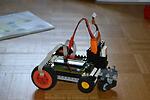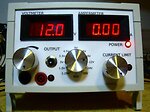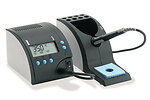 Lego robot is a cheaper alternative to a (too) expensive LEGO NXT. Two HUB-ee wheels are used for driving. It is controlled by two AVR microcontrollers - ATTiny 2313A takes care of PID control, soft-power button and USB communication over ft232, ATMega 32A is user programmable (over USB and ATTiny) and it controls everything else. On main PCB are also a 1117 5v regulator, standard hd44780 2x16 character LCD, a few buttons, a speaker and connectors for external sensors and LEDs.
Read more →
Lego robot is a cheaper alternative to a (too) expensive LEGO NXT. Two HUB-ee wheels are used for driving. It is controlled by two AVR microcontrollers - ATTiny 2313A takes care of PID control, soft-power button and USB communication over ft232, ATMega 32A is user programmable (over USB and ATTiny) and it controls everything else. On main PCB are also a 1117 5v regulator, standard hd44780 2x16 character LCD, a few buttons, a speaker and connectors for external sensors and LEDs.
Read more →
 Description The circuit uses 555 and 4017 integrated circuits to turn each of the 10 LEDs one after another. The LEDs are placed in a circle to create the effect of spining - just like a light in a lighthouse. The speed can be controlled with a variable resistor.
I am selling on tindie:\
Operation Required skills Knowledge of basic electronic components Soldering of THT components Theory LED diodes 555 integrated circuit 4017 IC The kit for building a DIY lighthouse contains following items Main printed circuit board 47k, 10k, 330R resistors 1M variable resistor (trimmer) 100uF, 0,47uF, 100nF capacitors 555, 4017 ICs with sockets 90 degrees header LED pcb 10 white LEDs Battery connector Wire Switch Assembly First you have to solder sockets for both ICs on the main pcb (rectangular, green).
Read more →
Description The circuit uses 555 and 4017 integrated circuits to turn each of the 10 LEDs one after another. The LEDs are placed in a circle to create the effect of spining - just like a light in a lighthouse. The speed can be controlled with a variable resistor.
I am selling on tindie:\
Operation Required skills Knowledge of basic electronic components Soldering of THT components Theory LED diodes 555 integrated circuit 4017 IC The kit for building a DIY lighthouse contains following items Main printed circuit board 47k, 10k, 330R resistors 1M variable resistor (trimmer) 100uF, 0,47uF, 100nF capacitors 555, 4017 ICs with sockets 90 degrees header LED pcb 10 white LEDs Battery connector Wire Switch Assembly First you have to solder sockets for both ICs on the main pcb (rectangular, green).
Read more →
 I finally managed to finish my first adjustable bench power supply, that I designed a long time ago when I was just beginning in the field of electronics. That is why it is not the best power supply possible, but it will satisfy most of my needs. Advantages: Preselected commonly used voltages and an option to set voltage accurately with a 10-turn potentiometer Current limit Linear regulator Clear and accurate current and voltage meter display Small dimensions Nice look for a DIY Fast and simple on/off switch for output voltage with a simple button Disadvantages: Because it has only one transformer winding with quiet high voltage (30V) and is linearly regulated a lot of power and heat is produced so current is limited to about 1.
Read more →
I finally managed to finish my first adjustable bench power supply, that I designed a long time ago when I was just beginning in the field of electronics. That is why it is not the best power supply possible, but it will satisfy most of my needs. Advantages: Preselected commonly used voltages and an option to set voltage accurately with a 10-turn potentiometer Current limit Linear regulator Clear and accurate current and voltage meter display Small dimensions Nice look for a DIY Fast and simple on/off switch for output voltage with a simple button Disadvantages: Because it has only one transformer winding with quiet high voltage (30V) and is linearly regulated a lot of power and heat is produced so current is limited to about 1.
Read more →
 Ersa RDS80 is a great soldering station for hobby use, that offers a lot for an affordable price. But it has one weakness - an unappropriate cable for the soldering iron. It is neither heat resistant nor flexible. After using the soldering station for two years, I decided it was time to change the cable.
Although the connector on the soldering station has 4 contacts, only 3 of them are used and the cable has three wires.
Read more →
Ersa RDS80 is a great soldering station for hobby use, that offers a lot for an affordable price. But it has one weakness - an unappropriate cable for the soldering iron. It is neither heat resistant nor flexible. After using the soldering station for two years, I decided it was time to change the cable.
Although the connector on the soldering station has 4 contacts, only 3 of them are used and the cable has three wires.
Read more →
 I’ve already had a programmer for Atmel’s AVR microcontrollers, but I couldn’t use it in my lab, because my laptop doesn’t have a LPT port. So I decided to make a new programmer with USB connection. I’ve found an open source programmer AVR doper, and for the basis I took a modified version from the http://www.kreuzholzen.de web page. I designed a new singled sided PCB board, that I was able to make at home.
Read more →
I’ve already had a programmer for Atmel’s AVR microcontrollers, but I couldn’t use it in my lab, because my laptop doesn’t have a LPT port. So I decided to make a new programmer with USB connection. I’ve found an open source programmer AVR doper, and for the basis I took a modified version from the http://www.kreuzholzen.de web page. I designed a new singled sided PCB board, that I was able to make at home.
Read more →
 This programmer is a simple version of STK-200 ISP AVR programmer. I designed it using several schematics from the internet as a basis. It is not my design, I simply combined several designs and designed the pcb.
The programmer can be connected to computer with a lpt cable. It’s a very simple design and uses only one IC - the 74hc244 buffer. It’s used to convert different voltage levels between computer and the programmed AVR microcontroller.
Read more →
This programmer is a simple version of STK-200 ISP AVR programmer. I designed it using several schematics from the internet as a basis. It is not my design, I simply combined several designs and designed the pcb.
The programmer can be connected to computer with a lpt cable. It’s a very simple design and uses only one IC - the 74hc244 buffer. It’s used to convert different voltage levels between computer and the programmed AVR microcontroller.
Read more →
 Lego robot is a cheaper alternative to a (too) expensive LEGO NXT. Two HUB-ee wheels are used for driving. It is controlled by two AVR microcontrollers - ATTiny 2313A takes care of PID control, soft-power button and USB communication over ft232, ATMega 32A is user programmable (over USB and ATTiny) and it controls everything else. On main PCB are also a 1117 5v regulator, standard hd44780 2x16 character LCD, a few buttons, a speaker and connectors for external sensors and LEDs.
Read more →
Lego robot is a cheaper alternative to a (too) expensive LEGO NXT. Two HUB-ee wheels are used for driving. It is controlled by two AVR microcontrollers - ATTiny 2313A takes care of PID control, soft-power button and USB communication over ft232, ATMega 32A is user programmable (over USB and ATTiny) and it controls everything else. On main PCB are also a 1117 5v regulator, standard hd44780 2x16 character LCD, a few buttons, a speaker and connectors for external sensors and LEDs.
Read more →
 Description The circuit uses 555 and 4017 integrated circuits to turn each of the 10 LEDs one after another. The LEDs are placed in a circle to create the effect of spining - just like a light in a lighthouse. The speed can be controlled with a variable resistor.
I am selling on tindie:\
Operation Required skills Knowledge of basic electronic components Soldering of THT components Theory LED diodes 555 integrated circuit 4017 IC The kit for building a DIY lighthouse contains following items Main printed circuit board 47k, 10k, 330R resistors 1M variable resistor (trimmer) 100uF, 0,47uF, 100nF capacitors 555, 4017 ICs with sockets 90 degrees header LED pcb 10 white LEDs Battery connector Wire Switch Assembly First you have to solder sockets for both ICs on the main pcb (rectangular, green).
Description The circuit uses 555 and 4017 integrated circuits to turn each of the 10 LEDs one after another. The LEDs are placed in a circle to create the effect of spining - just like a light in a lighthouse. The speed can be controlled with a variable resistor.
I am selling on tindie:\
Operation Required skills Knowledge of basic electronic components Soldering of THT components Theory LED diodes 555 integrated circuit 4017 IC The kit for building a DIY lighthouse contains following items Main printed circuit board 47k, 10k, 330R resistors 1M variable resistor (trimmer) 100uF, 0,47uF, 100nF capacitors 555, 4017 ICs with sockets 90 degrees header LED pcb 10 white LEDs Battery connector Wire Switch Assembly First you have to solder sockets for both ICs on the main pcb (rectangular, green).
 I finally managed to finish my first adjustable bench power supply, that I designed a long time ago when I was just beginning in the field of electronics. That is why it is not the best power supply possible, but it will satisfy most of my needs. Advantages: Preselected commonly used voltages and an option to set voltage accurately with a 10-turn potentiometer Current limit Linear regulator Clear and accurate current and voltage meter display Small dimensions Nice look for a DIY Fast and simple on/off switch for output voltage with a simple button Disadvantages: Because it has only one transformer winding with quiet high voltage (30V) and is linearly regulated a lot of power and heat is produced so current is limited to about 1.
I finally managed to finish my first adjustable bench power supply, that I designed a long time ago when I was just beginning in the field of electronics. That is why it is not the best power supply possible, but it will satisfy most of my needs. Advantages: Preselected commonly used voltages and an option to set voltage accurately with a 10-turn potentiometer Current limit Linear regulator Clear and accurate current and voltage meter display Small dimensions Nice look for a DIY Fast and simple on/off switch for output voltage with a simple button Disadvantages: Because it has only one transformer winding with quiet high voltage (30V) and is linearly regulated a lot of power and heat is produced so current is limited to about 1.
 Ersa RDS80 is a great soldering station for hobby use, that offers a lot for an affordable price. But it has one weakness - an unappropriate cable for the soldering iron. It is neither heat resistant nor flexible. After using the soldering station for two years, I decided it was time to change the cable.
Although the connector on the soldering station has 4 contacts, only 3 of them are used and the cable has three wires.
Ersa RDS80 is a great soldering station for hobby use, that offers a lot for an affordable price. But it has one weakness - an unappropriate cable for the soldering iron. It is neither heat resistant nor flexible. After using the soldering station for two years, I decided it was time to change the cable.
Although the connector on the soldering station has 4 contacts, only 3 of them are used and the cable has three wires.
 I’ve already had a programmer for Atmel’s AVR microcontrollers, but I couldn’t use it in my lab, because my laptop doesn’t have a LPT port. So I decided to make a new programmer with USB connection. I’ve found an open source programmer AVR doper, and for the basis I took a modified version from the http://www.kreuzholzen.de web page. I designed a new singled sided PCB board, that I was able to make at home.
I’ve already had a programmer for Atmel’s AVR microcontrollers, but I couldn’t use it in my lab, because my laptop doesn’t have a LPT port. So I decided to make a new programmer with USB connection. I’ve found an open source programmer AVR doper, and for the basis I took a modified version from the http://www.kreuzholzen.de web page. I designed a new singled sided PCB board, that I was able to make at home.
 This programmer is a simple version of STK-200 ISP AVR programmer. I designed it using several schematics from the internet as a basis. It is not my design, I simply combined several designs and designed the pcb.
The programmer can be connected to computer with a lpt cable. It’s a very simple design and uses only one IC - the 74hc244 buffer. It’s used to convert different voltage levels between computer and the programmed AVR microcontroller.
This programmer is a simple version of STK-200 ISP AVR programmer. I designed it using several schematics from the internet as a basis. It is not my design, I simply combined several designs and designed the pcb.
The programmer can be connected to computer with a lpt cable. It’s a very simple design and uses only one IC - the 74hc244 buffer. It’s used to convert different voltage levels between computer and the programmed AVR microcontroller.